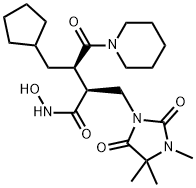CIPEMASTAT

CIPEMASTAT 性质
| 熔点 | >156°C (Dec.) |
|---|---|
| 密度 | 1.205±0.06 g/cm3(Predicted) |
| 储存条件 | Store at -20°C |
| 溶解度 | 可溶于氯仿(少许)、甲醇(少许) |
| 形态 | 固体 |
| 酸度系数(pKa) | 9.16±0.40(Predicted) |
| 颜色 | 浅米色至米色 |
CIPEMASTAT 用途与合成方法
|
collagenases 1 3.0 nM (Ki) |
collagenases 2 4.4 nM (Ki) |
collagenases 3 3.4 nM (Ki) |
stromelysins 1 527 nM (Ki) |
gelatinase A 154 nM (Ki) |
gelatinase B 59.1 nM (Ki) |
Cipemastat (Ro 32-3555) is a potent, competitive inhibitor of human matrix metalloproteinases. Cipemastat is selective for collagenase 1, 2 and 3 relative to related matrix metalloproteinases. Cipemastat is also a potent inhibitor of rat collagenase (IC 50 =44.7±3.4 nM (n=4)). In vitro cartilage degradation ± inhibited IL-1a induced cartilage degradation in vitro in a concentration-dependent manner with an IC 50 =60 nM. The inhibition is not mediated by a cytotoxic action on explant chondrocytes. Cipemastat, at all concentrations tested, fail to modify glucose utilization when compared to explants cultured in the presence of IL-La alone.
The amount of hydroxyproline in non-implanted cartilage is 119.3±4.2 nM/mg and this decreases in cartilages implanted in vehicle-dosed animals to 53.6±7.1 nM/mg over a fourteen day period. Animals administered Cipemastat orally at doses of 2.5, 5, 10 and 25 mg/kg show statistically increased levels of implanted cartilage hydroxypro-line. Fourteen days after the second challenge injection of P. acnes , the area of cartilage most consistently affected by pannus is the lateral femoral condyle, which is the area analysed. In non-arthritic animals the mean cartilage area is 0.17±0.02 mm 2 (n=5). In arthritic animals there is a significant decrease to a mean area of 0.086±0.01 mm 2 (n=10). The group of animals dosed with Cipemastat (50 mg/kg, p.o.) show a significantly greater area of cartilage with a mean value of 0.126±0.012 mm 2 (n=9). The pannus area in vehicle-dosed animals is 0.099±0.017 mm 2 and in Cipemastat dosed animals 0.102±0.019 mm 2 . Adjuvant arthritis injection of adjuvant induced two phases of swelling of the injected paw in vehicle-dosed rats. The primary swelling phase occurred between days 0 to 5 and induced an increase in paw volume of 1.9±0.1 mL; the secondary phase occurrs between day 9 to 14 and there was an increase in paw swelling of 0.98±0.08 mL. The group of animals dosed with dexamethasone (0.1 mg/kg) shows a significant reduction in both primary (0.2±0.03 mL) and secondary inflammation (0.07±0.08 mL) paw swelling as well as total inhibition of the lesion score.

